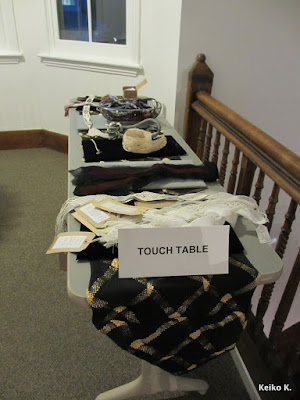 | |
| Obi braided by Makiko Tada, Japan Original obi tie method by Matsuko Levin, US Kimono on loan from the collection of Matsuko Levin |
After attending the MFA panel on Kimono Wednesdays on Sunday I dashed off to Newton to the opening reception of Twisted Again: The New Kumihimo, an exhibit of kumihimo art. Kumihimo is a Japanese textile art that traditionally involves the braiding of silk strands to make a cord. The exhibit showcases the work of six female artists from Japan, the US, the UK, and Australia who work with a variety of materials from the more traditional silk to modern materials such as monofilament. The pieces were really diverse and beautiful. It's a little out of the way for those who live in the city, but well worth the trip.
Twisted Again: The New Kumihimo
Follow the tracks of the ancient caravans and nomadic peoples throughout the world and you will find braids – fiber interlaced on the bias to make strong bands, belts, and cords needed to make everyday life possible. Using natural fibers of different shades, wonderful patterns emerged. When traders came to a natural stopping point, like the Island of Japan, various stands to make the braids were invented and perfected making possible more and more complex braids using dozens of bobbins of many colors in multiple layers. The Japanese word for making these complex braids is “Kumihimo”.
While there is no census, and there are many braiders and ways to braid, maybe only 100 or so people in the world work at the advanced levels of Kumihimo. In the making, there is a great sense of connection with the past and pleasure in rediscovering and perfecting the traditional patterns and working with the silk made in Japan only for work in Kumihimo. But for some, Kumihimo is also a path for innovation and personal expression. It becomes not just a technique but an art medium. We celebrate this group in this show.
Our show brings together the work of six artists using the Kumihimo braiding techniques, all of whom are innovators with a unique voice. This first in the US show combines work from four continents: Australia, Japan, the UK, and the US. When you come to the show, you will have a unique opportunity to listen in on the conversation between individuals and cultures as seen through these works. Some follow an engineering approach – inventing new braid structures to create never-before-seen patterns and effects. Others follow a more evolutionary approach, experimenting with the process to see what will emerge as a piece grows. While the traditional silk is still much in evidence, all of the artists experiment with different materials and fibers including paper, monofilament, and wire. Some want some functionality in their work and so have gone in the direction of fashion applications, true wearable art. Others have left functionality and focus on art expression. But no matter the direction of exploration, these works all exude the joy and delight of discovery.
Date & Time
Open through Saturday, February 20, 2016
(Note: Some sites and materials mistakenly show the exhibit as being open through the 22nd.)
Informal conversation with curator and artist, Lyn Christiansen, on Friday, February 12, 2016, 4:00 - 6:00pm.
Please see the exhibit website for hours.
Location
Wedeman Gallery at the Yamawaki Art and Cultural Center at Lasell College
47 Myrtle Ave., Newton, MA 02466
Admission
Free
 |
| Flowers, Flowers, Flowers Hiroko Ojima, Japan |
 |
| Pieces by Jacqui Carey, UK |
 |
| Wheel of Fortune Lyn Christiansen, US |
A nice feature of the exhibit is that there's a "Touch Table" with examples of most of the work in the exhibit. As a fiber artist I always want to touch textile arts, but it's a rarity to be able to do so. This was a great idea.
This was a completely unexpected find. Apparently Lasell College has owned this Japanese temple bell from Myokoku (outside Kyoto) since the 1800s when it was bought by Milton S. Vail, a friend of Lasell's principal, Dr. Charles C. Bragdon. This is not the only Japanese temple bell in the area. There is another Edo era Japanese temple bell in the Back Bay Fens. The Emerald Necklace Conservancy offers docent-led tours to see it.
 |
| Japanese Temple Bell early 1800s, Edo period |
Additional photos here.

No comments:
Post a Comment